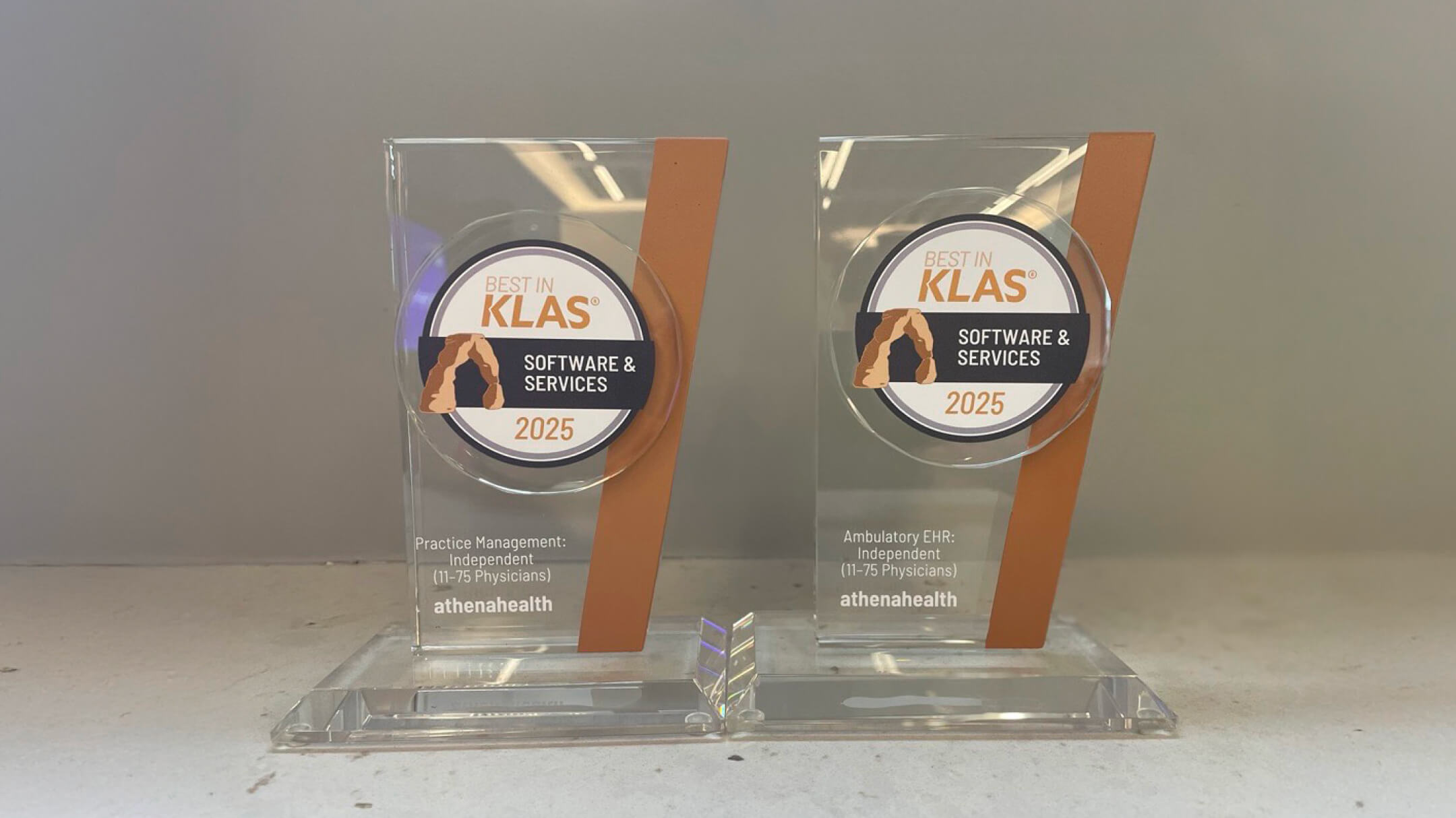The recurring pain of patient charting—and how to cure it
For physicians and clinicians, the patient encounter doesn’t typically end when the patient walks out the door. That’s largely due to the burden of patient charting. Many clinicians spend hours after work every week completing their medical charting tasks. According to the athenahealth 2025 Physician Sentiment Survey1, clinicians estimate that they spend an average of 13.3 hours a week working outside of their normal business day. One in four say that after-hours charting can take an extra 16 hours a week or more.2
Fortunately, there’s good news. The EHR embedded in athenaOne® has been designed to cure the complexity of medical charting through thoughtful tools and accelerators that help clinicians chart faster and more efficiently. The goals: to increase physician satisfaction by freeing them to practice medicine at the top of their license, and to boost patient satisfaction by allowing clinicians to focus on the patient instead of the computer screen.
Improving EHR efficiency can also contribute to a practice’s overall financial performance. For one thing, a practice cannot start a claim until the patient encounter is closed, so the faster clinicians can close the encounter, the sooner the practice can get paid. For another, lightening the load of patient charting could free up enough clinician time to see more patients per day, which can also boost practice performance.
Let’s take a look at the many features of athenaOne that help clinicians chart faster.
Before the encounter: Chart preparation and pre-population
Clinicians using athenaOne can save time during the patient encounter by handling some chart preparation tasks up to seven days in advance. At Summit Health, for instance, many clinicians pre-populate the history of present illness (HPI) with key issues that need to be addressed. Summit’s Chief Quality Officer, Dr. Ashish Parikh, says by taking advantage of chart preparation in athenaOne, he’s able to deliver better in-person care because encounters can be more focused.
Dr. Vik Mali, owner of Mali & Mali Pediatrics, says that chart prep along with athenaOne Voice Solutions have changed his life. By using chart prep to review the next day’s patients and their history, he says, “My notes are done before I’ve even walked in the room, because I’ve done chart prep and I’ve used it with Voice Solutions.” Dr. Mali appreciates the impression this makes on his pediatric patients and their parents. With chart prep, he explains, “By the time you walk into the [patient encounter,] you look very prepared.”
Full speed ahead, efficiently: Using accelerators
Much of the work of patient charting is repetitive. Clinicians don’t need to find a unique way to express the same diagnosis or capture similar symptoms from one patient to the next, but they do have to capture it in the patient chart. That’s where using accelerators can help clinicians write medical notes faster without sacrificing quality of information.
Accelerators in the EHR in athenaOne save time by enabling the clinician to add information to the patient chart with fewer clicks and keystrokes. Some examples from athenaOne include:
1. Text macros
Used throughout athenaOne’s EHR, text macros let clinicians populate fields with frequently used phrases, notes, prescriptions, and the like by typing just a few letters. Over time, the EHR learns which ones the clinician uses the most and prioritizes them for speedy access.
At Valley Medical Group, the use of text macros has helped care teams facilitate documentation and build stronger, more personal relationships with patients. “We make room for the provider to have a relationship with the patient, and take away tasks that detract from that,” says Martha Mastroberti, the practices healthcare informatics manager. Her colleague, medical director Dr. Steven Esrick, adds, “Right off the bat, we went from an average of six minutes down to about two minutes per note.”*
2. Saved templates
A saved template is an accelerator that simplifies the overall flow of a patient encounter. Clinicians can curate templates based on the kinds of visits they typically have, such as wellness visits, cold & flu season, specialty-specific encounters, and so on. A template offers multiple fields for the clinician to fill in, so they can populate a note with just a few clicks. As an example, an orthopedist might use a knee pain template when completing the patient’s HPI. The template provides the structure of the note, enabling the orthopedist to fill in details such as left, right, or both knees; date of onset of symptoms; and how the patient has managed pain so far, such as with ice or over-the-counter drugs.
For athenaOne’s specialty customers, an array of specialty templates is pre-loaded into the EHR so the specialist can hit the ground running. There is no additional charge to access or use these templates.
3. Saved findings
With a saved findings accelerator, the physician can pre-populate positive and negative reviews of systems (ROS) as well as findings from the physical exam. For instance, saved findings for dermatology could populate all normal values for all systems except for integumentary, the system most likely to need the dermatologist’s input. At that point, all the dermatologist has to do is answer positives and negatives for that system. The clinician can access the other systems at any time if there’s another finding or detail to update.
The ten providers that we had in the Ambient [Notes] trial, their feedback was, ‘I’m leaving here, and my notes are done for the day.’ The patients are able to communicate better with them because there’s more face-to-face time.
Jessie Storey, Director of IT, Mountain Laurel Medical Center
4. Order sets
Clinicians can speed up their assessment and plan documentation by including an order set. This accelerator links a set list of orders to specific diagnoses, automatically adding those orders to an Assessment & Plan with a relevant diagnosis. Orders may include medications, labs, imaging, vaccines, durable medical equipment, procedures, patient education, referrals, and so on.
Returning to the example of the orthopedist, an order set for a diagnosis of knee pain may include orders for an X-ray, a knee brace, ibuprofen, pre-op clearance, physical therapy, patient education, and a procedure. The orthopedist can tailor the set on the spot, removing anything that isn’t necessary for that patient, then sign the order. This saves the repetitive work of finding and selecting each order individually for every single patient with a similar diagnosis.
5. Encounter plans
The real time-saving power move is for a clinician to leverage as many of these medical charting accelerators as possible, all at once. For enhanced efficiency, athenaOne offers encounter plans as the ultimate, all-encompassing accelerator.
An encounter plan links a specific encounter reason or follow-up diagnosis to a set of diagnoses, orders, and templates. The clinician can preload these items into the encounter plan, then bring them all into the patient chart with a few keystrokes. That way, instead of searching for each one separately, the clinician can focus on filling in the details for that individual patient. It’s a powerful way to save time and maintain consistent patient records.
6. Specialty workflows
Certain specialists using athenaOne can access clinical workflows designed with that specialty’s specific needs in mind. The workflows reflect the way the specialists work, placing the right fields and content where they’re needed so the clinician can move through the encounter with ease.
One example of this is the pregnancy encounter workflow in athenaOne® for Women’s Health. For a patient in her 13th week of pregnancy, for instance, routine orders for that stage are already pre-populated in the OB episode via the encounter plan. The clinician can see those routine orders and update them if necessary for that patient.
At Advantage Orthopedic & Sports Medicine Clinic, orthopedic-specific workflows and documentation tools, including content templates and text macros, have significantly reduced the amount of time its clinicians spend on patient charting. Before switching to athenaOne, the clinic’s providers were spending as many as three hours per day on documentation after patient visits were over. After the switch, one physician reported saving 75 minutes during the day, and an extra two hours of after-work documentation time.*
Faster charting and navigation with Voice Solutions
Another athenaOne tool that helps clinicians write medical notes faster is athenaOne® Dictation powered by Nuance®. This fully integrated, voice-guided tool allows the clinician to navigate hands-free through the patient chart, open screens such as HPI, Assessment & Plan, and ROS, and toggle dictation on and off with simple voice commands. Then, the clinician can dictate her notes instead of having to type them during or after the encounter. athenaOne Dictation helps clinicians save time while documenting quickly, accurately, and in real time, which contributes to both clinician and patient satisfaction.
38% of new product features introduced in athenaOne in 2024 arose from customer input; we implemented around 360 of our customers’ ideas that year.
Improving EHR efficiency with AI-powered Ambient Notes
For physicians who wish they had an assistant to handle medical charting on their behalf, AI offers a valuable, time-saving solution. Now available in athenaOne, Ambient Notes uses ambient listening and generative AI technology to automate clinical note generation during the patient encounter. The technology summarizes the clinician’s conversation with the patient, capturing clinical observations, assessment, and plan, along with the patient’s concerns. The note is generated automatically, and the clinician can review it before placing it in the chart.
Recognizing that different clinicians may have their own preferred documentation styles, Ambient Notes offers a choice of ambient scribe models, including Suki AI, iScribe AI, and Abridge. Every clinician at the practice can choose the model they like best or try out each one to find the right fit. This level of flexibility sets Ambient Notes tool apart.
At Mountain Laurel Medical Center, Jessie Storey, Director of IT, says his clinicians are already delighted with Ambient Notes and the efficiency it brings. He reports, “The ten providers that we had in the Ambient trial, their feedback was, ‘I’m leaving here, and my notes are done for the day.’ The patients are able to communicate better with them because there’s more face-to-face time.”
Storey also mentions that Ambient Notes helps remind clinicians of details they might otherwise forget. “Sometimes you get into the flow of the visit… and you forget that thing that the patient just said that might alter your medication or something like that. So it’s actually reminding the provider after the visit of key pieces of information.” Being able to capture crucial details without spending extra time on charting—for the clinician and the patient, it’s a win-win.
We can hear you now: from clinician feedback to more efficient medical charting
At athenahealth, it’s important for us to hear and understand physicians’ pain points around patient charting—not just to express empathy, but to make real changes that help them chart more efficiently every day. In fact, 38% of new product features introduced in athenaOne in 2024 arose from customer input; we implemented around 360 of our customers’ ideas that year.3 Some recent customer-inspired enhancements that save time and keystrokes during patient charting include customizable drop-down content in the patient banner and flags for specific conditions in a patient’s history.
Deb Reid, owner of Instinctive Wellness, appreciates the way athenaOne improves every year and leverages customer feedback. “athena’s ability to constantly improve and to listen to the pain points that we have as providers and to see where we can be more efficient, [with] less chaos and more time for our own lives, more time for patients, is such a huge gift,” she says.
Chart smarter, not harder, with athenaOne
These athenaOne tools can have a measurable impact on the time your clinicians spend on medical charting before, during, and after the patient encounter. Just ask our customer HarmonyCares. One of our newest customers, this provider of value-based, in-home primary care says that charting time per encounter has been reduced by more than 70% for its 200-plus providers. After just one week using athenaOne, HarmonyCares providers are already hitting our benchmarks for template utilization and same-day encounter close rates.4
Ready to see some of our efficient charting tools in action? Request a demo here, we’d love to show you around.
1. 2025 Physician Sentiment Survey of 1,001 physicians nationwide. January 2025 fielded by Harris Poll, sponsored by athenahealth.
2. 2025 Physician Sentiment Survey of 1,001 physicians nationwide. January 2025 fielded by Harris Poll, sponsored by athenahealth.
3. Based on athenahealth data as of Dec. 2024; M008, M012
4. Source: HarmonyCares, July 2025. These results reflect the experience of one particular practice and are not necessarily what every athenahealth client should expect.
* These results reflect the experience of one particular practice and are not necessarily what every athenahealth client should expect.
Dr. Vik Mali, Martha Mastroberti, Dr. Steven Esrick, and Deb Reid participate in athenahealth’s Client Advocacy Program. To learn more about the program, please visit athenahealth.com/client-advocate-hub.












